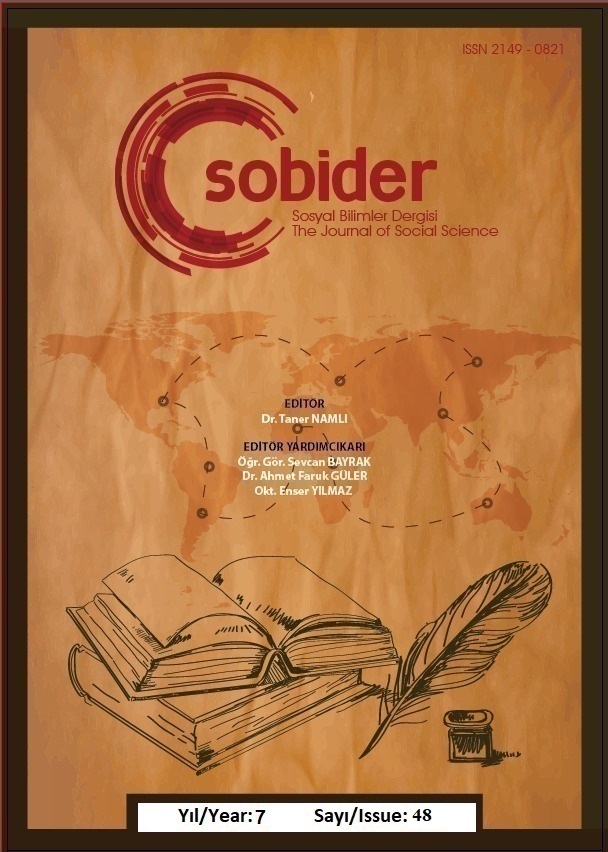Author :
Abstract
Bu araştırmanın amacı, ister kentsel, ister mimari, isterse ulaşımla ilgili olsun yönlendirme ve işaretleme tasarım öğelerinin grafik tasarım açısından gerekli koşullar belirlenerek bireyin bulunduğu mekânı daha iyi tanımasına imkân sağlamaktır. İyi tasarlanmış yönlendirme sistemleri birçok mekânda çevrenin daha iyi anlaşılması ve gezilmesini kolaylaştırması gezginlere keyifli bir deneyim sunar. Bu deneyimleri amaçlayan bireylerin bu mekânlara yeniden gelmelerini teşvik edebilecek olması ile birlikte, sosyal yaşamın bir o kadar gelişmesine de katkı sağlayacaktır. Araştırmada işaret sistemlerinin kullanıcılar tarafından kolayca anlaşılması açısından grafik tasarım aşamasında yapılacak tasarımların özellikleri neler olmalı ve nasıl bir süreçten geçirilerek etkili yön bulma çalışması yapılmalı sorusu problemi teşkil etmektedir. Etkili yönlendirmede işaretlerin ve grafiklerin mimari ya da iç tasarım öğeleri içermesi hedefe yönelmeleri açısından ziyaretçilere önemli ölçüde kolaylık sağlayacaktır. Bu araştırma dâhilinde yönlendirme tasarımlarının ve işaretlerin tüm öğelerinin incelenmesi, ayrıca grafik tasarımların kullanıcıların ihtiyaçlarının karşılanması bakımından görsel öğelerin öneminin daha net ve anlamlı olduğuna katkı sağlayacağı vurgulanmaya çalışılmıştır.
Keywords
Abstract
The aim of this research is to provide better recognition of the places where people are located by determining the necessary conditions in terms of graphic design of the orientation and marking design elements, whether urban, architectural or transportation related. For many venues, well-designed guidance systems make it easier to understand and navigate the environment, providing a better and more enjoyable experience for travelers. It can encourage people who aim for these experiences to return again and further improve social life. The question of what should be the features of the designs to be made in order to better understand the users in graphic design of research sign systems and how to make effective direction studies through a process ”is the problem. Effective orientation makes it easy for signs and graphics to orient, including clues with architectural or interior design elements to guide visitors to their destination. Within the scope of the research, it has been tried to emphasize that orientation designs and signs will contribute to the importance of visual elements in terms of graphic design in terms of meeting the needs of users.
Keywords
- Abdullah, R., & Hübner, R. (2006). Pictograms, Icons & Signs: A Guide to Information Graphics. Thames&Hudson.
- Adir, V., Pascu, N.-E., Adir, G., & Ivaşcu, L. (2017). Journal of Industrial Design and Engineering Graphics. ICI World of Journals , 1-5.
- Arthur, P., & Passini, R. (1992). Wayfinding: People, Signs, and Architecture. McGraw-Hill; 1st Edition edition.
- Atamaz, E., & Erdoğan, E. (2018). Graphic Design Applications for Spatial Imagery and Examples from a Nursery School. EURASIA Journal of Mathematics, Science and Technology Education, 948.
- Barnard, M. (2005). Graphic Design as Communication. New York: Routledge is an imprint of the Taylor & Francis Group.
- Becer, E. (2018). İletişim ve Grafik Tasarım. Ankara: Dost Kitapevi.
- Beier, S. (2012). Reading Letters: Designing for Legibility. BIS Publishers.
- Calori, C., & Eynden, D. (2015). Signage and Wayfinding Design. Canada: John Wiley & Sons, Inc., Hoboken, New Jersey.
- Çamdereli, M. (2006). Reklam Arası. Konya: Tablet Kitabevi.
- Edworthy, J., & Adams, A. (1996). Warning Design: A Research Prospective. London: Taylor & Francis.
- Fuller, G. (2002). The Arrow--Directional Semiotics: Wayfinding in Transit. Journal Social Semiotics.
- Gibson, D. (2009). The Wayfinding Handbook: Information Design for Public Places . New York: Princeton Architectural Press.
- Hardin, P. (1995). Arrows: A Special Case of Graphic Communication.
- Hollis, R. (2001). Graphic Design: A Concise History (World of Art). Thames and Hudson Ltd.
- Landa, R. (2011). Graphic Design Solutions. USA: Clark Baxter.
- MacEachren, A. M. (1995). How Maps Work: Representation, Visualization, and Design. New York: The Guilford Press.
- Mahnke, F. H. (1996). Color, Environment, and Human Response: An Interdisciplinary Understanding of Color and Its Use as a Beneficial Element in the Design of the Architectural Environment.
- Mollerup, P. (2016). The Challenge of Wayfi nding in Health Care Environments. R. H. Hunter, L. A. Anderson, & B. L. Belza içinde, Community Wayfi nding: Pathways to Understanding (s. 103-112). Switzerland: Springer Nature.
- Niron, I. (2009). The Importance of Environmental Graphic Design in Human Life and Its Affection.
- Read, M. A. (2003). Use of Color in Child Care Environments: Application of Color for Wayfinding and Space Definition in Alabama Child Care Environments. Early Childhood Education Journal, 30.
- Smitshuijzen, E. (2007). Signage Design Manual. Switzerland: Lars Muller.
- Tijus, C., Barcenilla, J., Lavalette, B., & Meunier, J. (2007). The design, understanding and usage of pictograms. Written Documents in the Workplace.
- Uebele, A. (2007). Signage Systems & Information Graphics. Thames & Hudson .
- Wogalter, M., Silver, N., Leonard, S., & Zaikina, H. (2016). Warning symbols. Handbook of Warnings, 159-176.
- Görsel 6: (Adir, Pascu, Adir, & Ivaşcu, 2017)
- Görsel 19: (Calori & Eynden, 2015)
